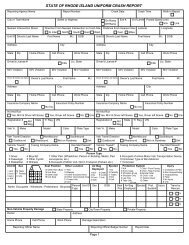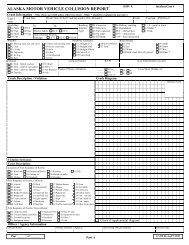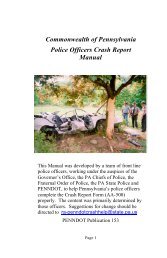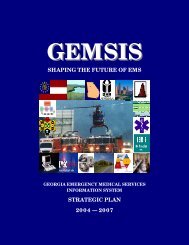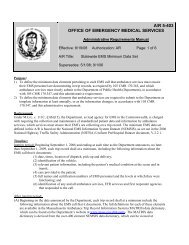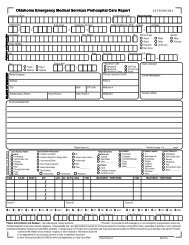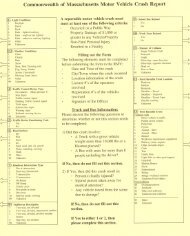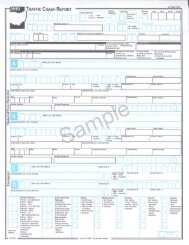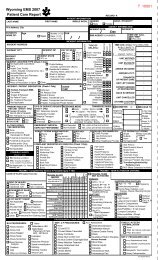State Data Dictionary - North Dakota Department of Health
State Data Dictionary - North Dakota Department of Health
State Data Dictionary - North Dakota Department of Health
You also want an ePaper? Increase the reach of your titles
YUMPU automatically turns print PDFs into web optimized ePapers that Google loves.
Version 2.0 09/18/2007<strong>North</strong> <strong>Dakota</strong> Electronic EMS ReportingHistory <strong>of</strong> SOAR:A <strong>North</strong> <strong>Dakota</strong> <strong>Department</strong> <strong>of</strong> <strong>Health</strong>, Division <strong>of</strong> EMS (NDEMS) data committee consisting <strong>of</strong>representatives from the NDEMS, the trauma registry, and field providers created the <strong>State</strong>Online Ambulance Reporting (SOAR) dataset in 2004. Originally consisting <strong>of</strong> 91-elements theSOAR dataset provided data collection to the NDEMS for 3 years. The NDEMS early on wascommitted to participation in NEMSIS and developed their system during the early years <strong>of</strong>NEMSIS conception. There was no way the NDEMS could fully anticipate the final NEMSISprocess as it matured two years later. This version 2 <strong>of</strong> the SOAR data dictionary incorporatesthe NEMSIS national data elements along with some <strong>of</strong> the original data elements that theNDEMS requires to provide adequate monitoring and reporting <strong>of</strong> Emergency Medical Services(EMS) activity in the <strong>State</strong> <strong>of</strong> <strong>North</strong> <strong>Dakota</strong>.NEMSIS Explanation:In 2001 the National Association <strong>of</strong> EMS Directors in conjunction with the National HighwayTraffic Safety Administration (NHTSA) and the Trauma/EMS systems program <strong>of</strong> <strong>Health</strong>Resources and Services Administration (HRSA) agreed to develop a national EMS database.From this agreement the NEMSIS project was grown. In 2003 the member states initiated amemorandum <strong>of</strong> understanding stating that they “recognized the need for EMS data collection atthe national level” and agreed to abide by the assignment <strong>of</strong> “specific definitions to a set <strong>of</strong> dataelements identified as desirable to be collected on a national level”. Between 2003 and 2005 theNEMSIS project developed an EMS and demographic dataset compiling them into a databookwith a defined Extended Markup Language (XML) schema to facilitate transport <strong>of</strong> the databetween systems. The databook consists <strong>of</strong> two datasets; the first is referred to as thedemographic dataset. This dataset collects information on the submitting agency, their vehicles,personnel, stations, medical equipment, protocols and medical direction. The second is referredto as the EMS dataset and collects information on the event or patient encounter. The elementscan be used to build an extensive patient care report for medical reporting purposes as well asdata collection. The current databook includes over 400 data elements that are recommended tobe included in an EMS data collection system and are also referred to as the Gold set. Knowingthe difficulty in collecting this many elements from end users, NEMSIS has created a subset <strong>of</strong>the data elements known as “National <strong>Data</strong> Elements” also referred as the Silver set. The Silversubset consists <strong>of</strong> a total <strong>of</strong> 83 elements, 67 elements (13 mandatory) in the EMS dataset and 16elements (8 mandatory) in the demographic dataset. NEMSIS and NHTSA require that states atminimum must collect the “National <strong>Data</strong> Elements” for submission to the national EMSdatabase. In April <strong>of</strong> 2006 the final release <strong>of</strong> the NEMSIS databook was published ands<strong>of</strong>tware vendor compliance testing initiated. NEMSIS and NHTSA are now requesting states tosubmit their data to the national EMS database.NEMSIS is attempting to remove the difficulty for EMS s<strong>of</strong>tware vendors in conductingbusiness in multiple regions or states. The movement to an accepted standardized datadictionary and XML with a standardized format removes the complaints <strong>of</strong> s<strong>of</strong>tware vendors inmodifying their s<strong>of</strong>tware between customers in different regions or states. NEMSIS <strong>of</strong>fers freecompliance tools and certification process for vendors to become NEMSIS compliant. ThesePage 6Copyright 2006-2007, <strong>North</strong> <strong>Dakota</strong> <strong>Department</strong> <strong>of</strong> <strong>Health</strong>, Division <strong>of</strong> EMS & Med-Media, Inc.



